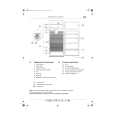|
|
|
Productos
|
|
Información
|
|
Destacado
|
|
|
 |
|
|
No hay comentarios de productos.
4. Kits & Sounds: Palette mode
ddrum4 SE V1.5x
4. KITS & SOUNDS KI SO
PALETTE
MODE
When you switch on the ddrum4 SE module, it will default to the Palette mode, indicated by �PAL� in the DISPLAY. Each one of the four main instrument groups, Kick, Snare, Toms and Percussion has a PALETTE button with which you can quickly choose one of five sound setups. You can also program your own selection of sounds in the Palette. See Chapter "6. Panel reference� on page 18 and onwards, for more details regarding programming.
Press the PALETTE buttons repeatedly to scroll through the five selections that are available for the different instrument groups. IMPORTANT! All editing is automatically stored in the Palette memory. Please be careful when you start to explore the different possibilities and parameters of the ddrum4 SE module. If you do this while being in Palette mode, the ddrum4 SE will store every changes you make. Until you are familiar with the ddrum4 SE parameters, do your exploring in Kit mode instead (See below).
KIT
MODE
If you turn the ROTARY DIAL clockwise from the Palette mode, the DISPLAY will change from �PAL� to a �P.� or an �F.� followed by a number. This is the Kit mode. The number identifies the 99 different drum kits that are available in the ddrum4 SE module. Keep turning the ROTARY DIAL to scroll through the kits. You can program your own selection of sounds in the �P.� kits, numbered from 1 to 26. The kits that are in the memory locations 27 to 99, indicated with an �F�. and a number in the display, are the ROM factory kits. The factory kits can be edited but you can only store any edits or sound selections to the �P.� (1-26) kits.
THE FACTORY PRESETS
The ddrum4 SE comes from factory with the following line-up of kits: � Kits P1-P5 all have long decaying tom sounds � Kits P6-P10 holds toms with shorter decay times and are intended mainly for use live. � Kits P11-P15 holds �latin percussion� kits
Page 14
|
|
 |
> |
|

